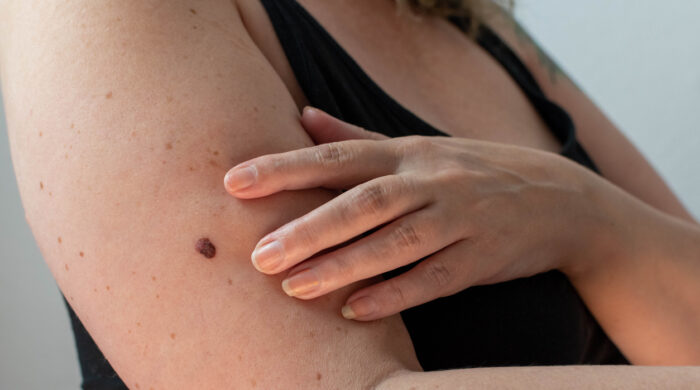Have you ever wondered if a colored spot on your skin is a mole… or could it be skin cancer? Being able to tell the difference between harmless moles and skin cancer could save your life, and early intervention is key.
Paying attention to your blemishes is important for early detection of potentially dangerous melanomas so you can get effective treatment.
Read on for a brief overview of moles and skin cancers such as melanoma, to help you decide whether or not it’s time to schedule an appointment with your health provider.
Mole, Melanoma, Skin Cancer: What’s the Difference?
Moles
Moles are clusters of pigmented cells that commonly appear on the skin as small, dark spots. They are usually harmless and can be something you’ve had since birth, or may develop over time due to sun exposure.
Melanoma
Melanoma, a type of skin cancer, is an irregular growth of cells that can develop from an existing mole or from normal skin cells. Melanoma is the most aggressive form of skin cancer and has the potential to spread to other parts of the body.
According to the American Cancer Society, melanoma is less common than other types of skin cancer, but it is more likely to grow and spread.
The American Cancer Society reports that the 5-year survival rate for localized melanoma is around 99%. Localized means it has not spread to other parts of the body. Survival rates are highest when melanoma is identified and treated at an early stage.
Skin Cancer
The term skin cancer encompasses various types of malignant (harmful) growths that affect the skin. While melanoma is a severe form, other types of skin cancer include basal cell carcinoma and squamous cell carcinoma, which are often linked to prolonged sun exposure.
In cases of skin cancer, early detection and differentiating between non-cancerous and malignant growths is important to ensure appropriate treatment.
Doing regular self-examinations and getting professional screenings from a medical provider are essential to maintain your skin health and catch potential issues early on.
Signs and Symptoms to Look For
Understanding the distinction between moles and cancerous growths involves a close examination of their physical characteristics.
Moles are typically benign (harmless) and exhibit a range of shapes, colors, and sizes. They can be flat or raised, brown or black, and may vary in diameter.
On the other hand, melanoma, a more serious form of skin cancer, demands your watchful attention and observation of any changes to the skin.
The ABCDE guide serves as a valuable tool for identifying potential signs of melanoma:
- A for asymmetry – is the blemish an irregular shape?
- B for irregular borders – does it have clear borders around it, or not?
- C for variations in color – is the blemish more than one color?
- D for diameter larger than a pencil eraser – how large is it?
- E for evolving changes over time – does it grow or change shape over time?
Monitoring these aspects of moles or skin blemishes can aid in early detection and help you know when to seek medical attention.
Risk Factors for Melanoma
Various factors contribute to the risk of developing melanoma, with genetic predisposition (family history) playing a large role.
The main risk factors for skin cancer are:
- A family history of melanoma.
- Environmental factors, such as prolonged exposure to ultraviolet (UV) radiation from the sun or artificial sources.
- Lifestyle influences, including tanning bed usage and a history of severe sunburns.
These risk factors may vary across different demographics, with age, ethnicity, geographic location, and sun exposure influencing one’s likelihood of getting skin cancer. For instance, older individuals and those with fair skin are generally at a higher risk, emphasizing the importance of prevention and screening.
Prevention Methods
Preventing melanoma and monitoring moles for potential signs of concern involves a multi-step approach:
- Take measures to protect yourself from the sun, such as wearing sunscreen and protective clothing, and avoiding excessive sun exposure.
- Regular skin checks, both self-examinations and professional screenings, play a pivotal role in early detection, and are crucial for reducing your risk of skin cancer.
Treating Melanoma
When it comes to treatment options for moles and melanoma, primary care providers play a vital role in assessment. There are actually a wide range of dermatology services offered in primary care.
In cases where skin cancer is suspected, your provider can write a referral to a dermatologist for more extensive evaluation.
Common treatment methods for skin cancer range from non-surgical interventions to surgical procedures, depending on the severity of the diagnosis.
Prioritize Skin Care
Prioritizing skin care is an important part of maintaining overall health and well-being. In addition, doing regular skin self-examinations, taking sun protection measures, and being aware of the signs of melanoma are essential steps to help you prevent and detect skin cancer early on.
If you have any concerns about a mole or notice changes in your skin, don’t ignore it. By seeking professional medical advice, you can support your overall health now and in the future. Request an appointment with a WWMG family medicine provider today.
Remember, your skin deserves the same attention and care as the rest of your body, so take charge and make that appointment today for a healthier tomorrow. Request an appointment with one of our primary care providers.
